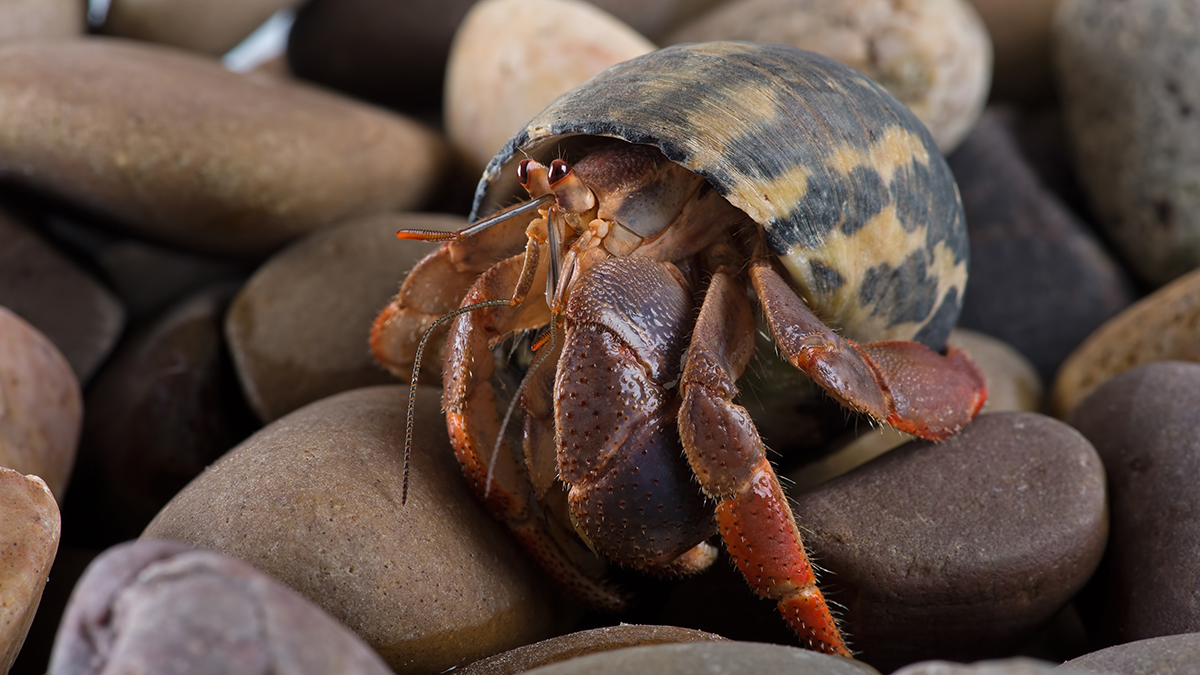
Species Overview
- Common Names: Hermit Crabs
- Scientific Name: Paguroidea
- Distribution: Throughout Central and Northern South America, the Caribbean and surrounding Islands
- Adult Size: 2″-6”
- Life Expectancy: 10+ years
Hermit Crabs can make fascinating pets that are hardy when kept in the proper conditions. Most Hermit Crabs kept as pets are the Atlantic Hermit Crab, also known as the Tree Crab. These crustaceans inhabit coastal areas of Central and South America. They are social creatures that can sometimes be found in large numbers while scavenging for food at night. Hermit Crabs can grow up to 4 inches, and by providing their basic needs, they can do well as pets.
About Hermit Crabs
Habitat Set-Up
Habitat
- A 10-gallon terrarium is sufficient for up to 6 small Hermit Crabs. A small-sized Hermit Crab is 2” or less.
- Larger hermit Crabs, 3 ½” or larger, need a 20-gallon terrarium. With a 20-gallon tank, you can house up to 3 or 4 Hermit Crabs.
- Hermit Crabs are social animals, but they need space. Do not overcrowd their environment.
- Zoo Med’s Naturalistic Terrarium or ReptiHabitat enclosures are great for Hermit Crabs.
- Provide plenty of climbing branches and a secure lid because Hermit Crabs love to climb.
- Hermit Crabs will outgrow their shells and are always on the search for their next home.
- Successfully, keeping a Hermit Crab requires that you provide several extra shells. These larger empty shells provide your pet with the room they need to grow.
Heating
- Daytime Terrarium Temperature 78-83 F.
- Nighttime Terrarium Temperature 68-73 F.
- Zoo Med’s Hermit Crab Heater is an excellent choice to provide supplemental heat to your Hermit Crabs.
- Nightlight Red Heat Bulbs are great for providing nighttime heat and just enough light to view their engaging nocturnal activities.
Substrates
- Hermit Crabs will need a deep layer of substrate material to burrow in. We recommend having at least 3″ of substrate throughout half of the enclosure.
- Mix 2 parts Zoo Med’s Hermit Crab Sand with 1 part Hermit Crab Soil (coconut bedding). This combination will create an ideal substrate layer that holds humidity and allows natural burrowing behaviors.
Diet and Nutrition
- Hermit Crabs are omnivorous scavengers that will eat a wide variety of foods.
- Zoo Med provides three essential food items that will make up a balanced diet when fed regularly.
- Zoo Med’s Hermit Crab Food and Fruit Salad are excellent choices for daily feedings.
- We recommend mixing Zoo Med’s Canned Hermit Crab Food with pelleted foods for a well-balanced meal.
Water
- Water is critical to the health and success of keeping Hermit Crabs in captivity.
- Hermit Crabs have gills similar to those of fish; this adaptation requires high humidity levels in your terrarium (70-90% relative humidity).
- Spray your Hermit Crab’s enclosure daily.
- Hermit Crabs will need two different water bowls with constant access to both fresh and saltwater.
- Use Zoo Med’s drinking water conditioner to remove chemicals such as Chlorine and Chloramines. Use Zoo Med’s Salt Water Conditioner to turn tap water into salt water.
Pet Safety
- Use caution when handling pets, and remember they may bite or scratch (especially when stressed).
- Supervise children around pets.
- ALL ANIMALS can potentially carry viral, bacterial, fungal, and parasitic diseases contagious to humans.
- Thoroughly wash your hands with warm, soapy water before and after contact with any pet or its habitat.
- Adults should assist children with handwashing after contact with a pet, its habitat, or aquarium water.
Related Searches
Crustacean Care